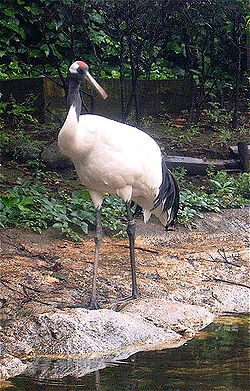Red-crowned crane
The red-crowned crane (Grus japonensis), also called the Japanese crane or Manchurian crane, is a large crane. It is the second rarest crane in the world after the North American whooping crane.[1] In East Asia, it is known as a symbol of luck and fidelity.[1] At 55 inches high, the crane does not make easy prey, for all that it stands out in its natural habitat of marshes and swamps. When it matures, the red-crowned crane is snow white with a patch of red skin on its head.
| Red-crowned crane | |
|---|---|

| |
| Scientific classification | |
| Kingdom: | |
| Class: | |
| Order: | |
| Family: | |
| Genus: | |
| Binomial name | |
| Grus japonensis | |
Description
changeIn the spring and summer, the red-crowned crane lives in Siberia, where their eggs hatch. Normally the crane lays two eggs, but usually only one chick survives.[1] Later, in the autumn, it migrates in flocks to Korea, Japan, China, Taiwan, and other countries in East Asia to spend the winter. All red-crowned cranes migrate, except for a flock that stays in Hokkaido, year long.[1]
Diet
changeThe crane eats small amphibians, aquatic invertebrates, insects, and plants that grow in marshes and swamps.
References
change- ↑ 1.0 1.1 1.2 1.3 "Red-crowned crane fact sheet". nationalzoo.si.edu. 2013. Archived from the original on 11 October 2012. Retrieved 27 March 2013.